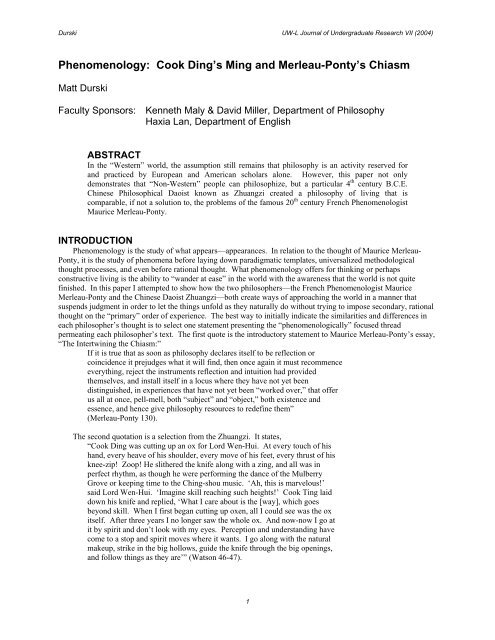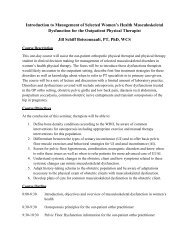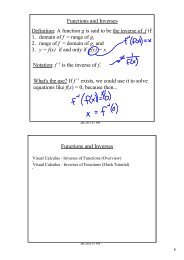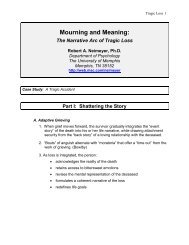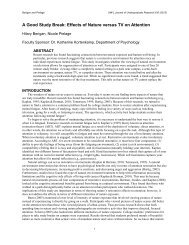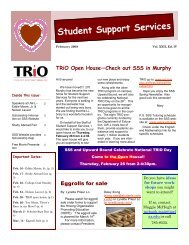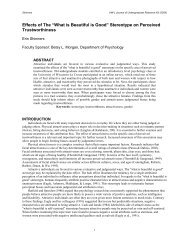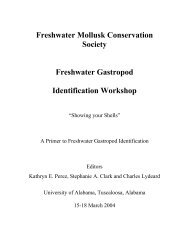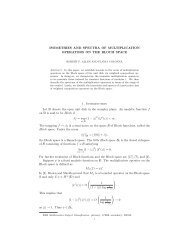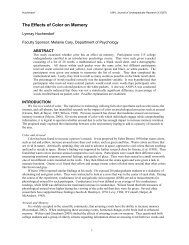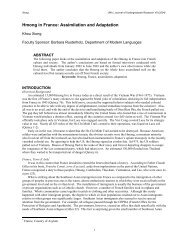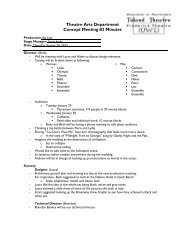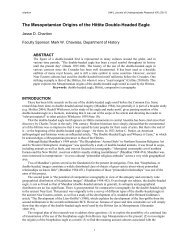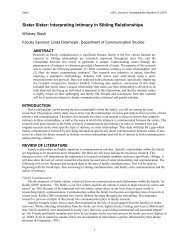Phenomenology: Cook Ding's Ming and Merleau-Ponty's Chiasm
Phenomenology: Cook Ding's Ming and Merleau-Ponty's Chiasm
Phenomenology: Cook Ding's Ming and Merleau-Ponty's Chiasm
You also want an ePaper? Increase the reach of your titles
YUMPU automatically turns print PDFs into web optimized ePapers that Google loves.
Durski UW-L Journal of Undergraduate Research VII (2004)<br />
<strong>Phenomenology</strong>: <strong>Cook</strong> Ding’s <strong>Ming</strong> <strong>and</strong> <strong>Merleau</strong>-Ponty’s <strong>Chiasm</strong><br />
Matt Durski<br />
Faculty Sponsors: Kenneth Maly & David Miller, Department of Philosophy<br />
Haxia Lan, Department of English<br />
ABSTRACT<br />
In the “Western” world, the assumption still remains that philosophy is an activity reserved for<br />
<strong>and</strong> practiced by European <strong>and</strong> American scholars alone. However, this paper not only<br />
demonstrates that “Non-Western” people can philosophize, but a particular 4 th century B.C.E.<br />
Chinese Philosophical Daoist known as Zhuangzi created a philosophy of living that is<br />
comparable, if not a solution to, the problems of the famous 20 th century French Phenomenologist<br />
Maurice <strong>Merleau</strong>-Ponty.<br />
INTRODUCTION<br />
<strong>Phenomenology</strong> is the study of what appears—appearances. In relation to the thought of Maurice <strong>Merleau</strong>-<br />
Ponty, it is the study of phenomena before laying down paradigmatic templates, universalized methodological<br />
thought processes, <strong>and</strong> even before rational thought. What phenomenology offers for thinking or perhaps<br />
constructive living is the ability to “w<strong>and</strong>er at ease” in the world with the awareness that the world is not quite<br />
finished. In this paper I attempted to show how the two philosophers—the French Phenomenologist Maurice<br />
<strong>Merleau</strong>-Ponty <strong>and</strong> the Chinese Daoist Zhuangzi—both create ways of approaching the world in a manner that<br />
suspends judgment in order to let the things unfold as they naturally do without trying to impose secondary, rational<br />
thought on the “primary” order of experience. The best way to initially indicate the similarities <strong>and</strong> differences in<br />
each philosopher’s thought is to select one statement presenting the “phenomenologically” focused thread<br />
permeating each philosopher’s text. The first quote is the introductory statement to Maurice <strong>Merleau</strong>-Ponty’s essay,<br />
“The Intertwining the <strong>Chiasm</strong>:”<br />
If it is true that as soon as philosophy declares itself to be reflection or<br />
coincidence it prejudges what it will find, then once again it must recommence<br />
everything, reject the instruments reflection <strong>and</strong> intuition had provided<br />
themselves, <strong>and</strong> install itself in a locus where they have not yet been<br />
distinguished, in experiences that have not yet been “worked over,” that offer<br />
us all at once, pell-mell, both “subject” <strong>and</strong> “object,” both existence <strong>and</strong><br />
essence, <strong>and</strong> hence give philosophy resources to redefine them”<br />
(<strong>Merleau</strong>-Ponty 130).<br />
The second quotation is a selection from the Zhuangzi. It states,<br />
“<strong>Cook</strong> Ding was cutting up an ox for Lord Wen-Hui. At every touch of his<br />
h<strong>and</strong>, every heave of his shoulder, every move of his feet, every thrust of his<br />
knee-zip! Zoop! He slithered the knife along with a zing, <strong>and</strong> all was in<br />
perfect rhythm, as though he were performing the dance of the Mulberry<br />
Grove or keeping time to the Ching-shou music. ‘Ah, this is marvelous!’<br />
said Lord Wen-Hui. ‘Imagine skill reaching such heights!’ <strong>Cook</strong> Ting laid<br />
down his knife <strong>and</strong> replied, ‘What I care about is the [way], which goes<br />
beyond skill. When I first began cutting up oxen, all I could see was the ox<br />
itself. After three years I no longer saw the whole ox. And now-now I go at<br />
it by spirit <strong>and</strong> don’t look with my eyes. Perception <strong>and</strong> underst<strong>and</strong>ing have<br />
come to a stop <strong>and</strong> spirit moves where it wants. I go along with the natural<br />
makeup, strike in the big hollows, guide the knife through the big openings,<br />
<strong>and</strong> follow things as they are’” (Watson 46-47).<br />
1
Durski UW-L Journal of Undergraduate Research VII (2004)<br />
To help clarify how each of these passages embody phenomenological thinking in uniquely different<br />
manners, I will proceed to highlight <strong>and</strong> summarize each philosopher’s key idea in this consideration beginning with<br />
Maurice <strong>Merleau</strong>-Ponty.<br />
THE CHIASM<br />
In his famous essay, “The Intertwining-The <strong>Chiasm</strong>,” <strong>Merleau</strong>-Ponty uses the term chiasm as the source to tie<br />
together the Classical Western Philosophical subject/object dilemma which most often states that the subject—that<br />
which throws things/objects under—or the individual mind, is set apart/against the objects—that which is thrown<br />
against our subject—of everyday empirical <strong>and</strong> cognitive experience is what is most primary to cognitive<br />
underst<strong>and</strong>ing. What is a chiasm? The word chiasm is a French word derived from chiasma meaning, “a crossing<br />
or decussation, as that of the optic nerves at the base of the brain” (Webster’s 356). He uses this word-image of<br />
crossing nerves letting us imagine that point at which the subject <strong>and</strong> object cross at the most basic level.<br />
Keeping true to optic phenomena <strong>and</strong> the word image of chiasm, he proceeds to study the perceptual realm of<br />
experience. The first way he does this, is through the study of the color red. He concludes, “a certain red is…less a<br />
color than a difference between things <strong>and</strong> colors, a momentary crystallization of colored being or of visibility”<br />
(<strong>Merleau</strong>-Ponty 132-133). What does this mean in less esoteric language? Essentially, it means that the color red<br />
that I experience <strong>and</strong> see is not the color red you experience <strong>and</strong> see, it means the color red is contextual <strong>and</strong><br />
relatively relative as opposed to permanent <strong>and</strong> universal. He argues this, because the color red which one perceives<br />
is dependent on how much light is present in the room, how one’s rods <strong>and</strong> cones are structured, as well as the other<br />
colors surrounding “red.” What this move accomplishes, is the breakdown of the historic duality between subject<br />
<strong>and</strong> object from the object’s perspective. We find that the object of perceptual analysis, red, is not a object<br />
containing inherent values <strong>and</strong> characteristics, but rather, red is defined by our participation with “it”.<br />
Next, <strong>Merleau</strong>-Ponty begins to study the subject in order to deconstruct the duality from the subject’s<br />
perspective. This goal is attained by studying the tactile interaction, the bodily consciousness between his two<br />
h<strong>and</strong>s. When the right h<strong>and</strong> is touching the left h<strong>and</strong>, <strong>and</strong> when the left h<strong>and</strong> is touching the right h<strong>and</strong>, it is noticed<br />
that our h<strong>and</strong>s become both touching objects <strong>and</strong> touching subjects. This sounds like a paradox, because if one<br />
conducts this experiment, one sees that selective perception only allows one to either feel one h<strong>and</strong> touching or<br />
being touched. However, one will also notice that both ways of feeling the touch are indeed accurate. From this we<br />
can conclude the physical sensation of the interaction between our h<strong>and</strong>s, are two halves of the sentient-sensible,<br />
object-subject relationship, <strong>and</strong> thus inextricably bound to one another in some manner. This relationship, this<br />
interaction between things in primary consciousness is precisely what <strong>Merleau</strong>-Ponty labels “<strong>Chiasm</strong>,” <strong>and</strong> is<br />
precisely where he is trying to arrive when he writes about getting into a locus before things have been “worked<br />
over.”<br />
MING<br />
In his Inner Chapters, Zhuangzi uses the character for “<strong>Ming</strong>” to describe the way the sage participates in the<br />
everyday activities in the world. Before I give any further explanation of what ming means in this work, I will<br />
define ming philosophically with the Dao De Jing: A Philosophical Translation written by Roger T. Ames <strong>and</strong><br />
David Hall. On pages 39 <strong>and</strong> 40 it states, it is “through ‘acuity (ming)’—a mirroring of the things of the world as<br />
they are in their interdependent relations with us—that we reach a state in which nothing among all of the “myriad<br />
goings on” in the world will be able to agitate our hearts-<strong>and</strong>-minds, <strong>and</strong> we are better able to promote the<br />
flourishing of our world. In other words, we defer in attaining integrity with those things that contextualize us,<br />
establishing a frictionless equilibrium with them.” For Zhuangzi, things do not intertwine in a theoretical chiasm.<br />
Rather, he thinks that we should attend to the way in which things intertwine <strong>and</strong> make meaning as they seem to fit<br />
into our contextual meaning structures of everyday life.<br />
For Zhuangzi, the sage is one who thinks that the affirmations <strong>and</strong> the denials characteristic of the Mohists <strong>and</strong><br />
the Confucians shed light on only a glimpse of the larger picture. For example, Zhuangzi retorts, “What is It is also<br />
Other, what is Other is also It. There they say ‘That’s it, that’s not’ from one point of view, here we say ‘That’s it,<br />
that’s not’ from another point of view. Are there really It <strong>and</strong> Other? Or really no It <strong>and</strong> Other” (Graham 53)? The<br />
value of constructing this type of duality lies in showing the arrogance <strong>and</strong> futility of people who argue not to<br />
underst<strong>and</strong> the other person’s perspective, but argue only because they refuse to move out of the absolute, value<br />
ridden schemes entrenching them in their unchangeable position. What one should do instead, is continuously<br />
attend to one’s surroundings, realizing that the distinction between it <strong>and</strong> other, subject <strong>and</strong> object are only<br />
“temporary lodging places” used to act appropriately to what each particular situation offers. By practicing life this<br />
way, one is able to attend, attune, <strong>and</strong> be connected on a mundane level to all experiences contextualizing our lives<br />
allowing us to become master butchers like <strong>Cook</strong> Ding.<br />
2
Durski UW-L Journal of Undergraduate Research VII (2004)<br />
METHOD<br />
The methods with which I researched <strong>and</strong> wrote this paper consisted of:<br />
a. Taking a <strong>Phenomenology</strong> seminar course with Dr. Kenneth Maly<br />
b. Taking a Zhuangzi “Directed Readings” course with Dr. Haixia Lan.<br />
c. Discussing the philosophical aspects of <strong>Phenomenology</strong> with Kenneth Maly<br />
d. Discussing the philosophical <strong>and</strong> rhetorical aspects of Philosophical Daoism <strong>and</strong> “Chinese” thinking<br />
with Haixia Lan.<br />
e. Intense reading of <strong>Merleau</strong>-Ponty’s, “The Intertwining—The <strong>Chiasm</strong>.”<br />
f. Intense reading of A.C. Grahams, Disputers of the Tao, Zhuangzi: The Inner Chapters, Heidegger’s<br />
view of language, Roger Ames collaborative works with David Hall <strong>and</strong> D.C. Lau on the Confucian<br />
Analects, the Dao De Jing, the Zhongyong, <strong>and</strong> Yuan Dao.<br />
g. Proofreading <strong>and</strong> commenting by Dr. David Miller, Kenneth Maly, <strong>and</strong> Haixia Lan.<br />
RESULTS/CONCLUSIONS<br />
After researching this topic for a large portion of an academic year <strong>and</strong> then letting my initial conclusions alone<br />
to see if they still check out with the research, I am confident I can make a more specific <strong>and</strong> concrete description of<br />
the way Zhuangzi’s Daoism <strong>and</strong> <strong>Merleau</strong>-Ponty’s <strong>Phenomenology</strong> share <strong>and</strong> differ from one another. I also feel I<br />
am in better position to comment on how Zhuangzi’s theory of living supplements or even corrects <strong>Merleau</strong>-Ponty’s<br />
speculative ontology.<br />
To clarify my results <strong>and</strong>/or conclusions, I will cite several passages from each book <strong>and</strong> attempt to show where<br />
Daoism dehisces from <strong>Phenomenology</strong>. On page 134 of The Visible <strong>and</strong> the Invisible the French thinker writes, “he<br />
who looks must not himself be foreign to the world that he looks at. As soon as I see, it is necessary that the<br />
vision…be doubled with a complementary vision or with another vision: myself seen from without, such as another<br />
would see me, installed in the midst of the visible…” On page 135 he concludes, “It is that the thickness of flesh<br />
between the seer <strong>and</strong> the thing is constitutive for the thing of its visibility as for the seer of his corporeity; it is not an<br />
obstacle between them, it is their means of communication. It is for the same reason that I am at the heart of the<br />
visible <strong>and</strong> that I am far from it: because it has thickness <strong>and</strong> is thereby naturally destined to be seen by a body.”<br />
On page 55 of Chuang-tzu: The Inner Chapters it is said, “There is ‘beginning’, there is ‘not yet having begun<br />
having a beginning’. There is ‘there not yet having begun to be that “not yet having begun having a beginning”’.<br />
There is ‘something’, there is ‘nothing’. There is ‘not yet having begun being without something’. There is ‘there<br />
not yet having begun to be that “not yet having begun being without something’.” On page 57 Zhuangzi remarks,<br />
“To ‘divide’, then, is to leave something undivided: to ‘discriminate between alternatives’ is to leave something<br />
which is neither alternative. ‘What?’ you ask. The sage keeps it in his breast, common men argue over alternatives<br />
to show it to each other. Hence I say: “To “discriminate between alternatives” is to fail to see something’. Lastly, I<br />
will give one conundrum <strong>and</strong> one story on dreaming. Zhuangzi quips, “While we dream we do not know that we are<br />
dreaming, <strong>and</strong> in the middle of a dream interpret a dream within it; not until we wake do we know that we were<br />
dreaming. Only at the ultimate awakening shall we know that this is the ultimate dream” (Graham 59-60). “Last<br />
night Chuang Chou dreamed he was a butterfly, spirits soaring he was a butterfly (is it that in showing what he was<br />
he suited his own fancy?), <strong>and</strong> did not know about Chou. When all of a sudden he awoke, he was Chou with all his<br />
wits about him. He does not know whether he is Chou who dreams he is a butterfly or a butterfly who dreams he is<br />
Chou. Between Chou <strong>and</strong> the butterfly there was necessarily a dividing; just this is what is meant by the<br />
transformation of things” (Graham 61).<br />
What is obvious from reading these passages is the different approach each philosopher engages to encounter<br />
the dilemma of lived experience. One could say that Maurice <strong>Merleau</strong>-Ponty’s attempt to “uncover” the chiasm is<br />
doomed to fail before it even begins. The reason for this conclusion strings forth from his initial construction of<br />
duality. When in the first paragraph of “The Intertwining-The <strong>Chiasm</strong>,” <strong>Merleau</strong>-Ponty speaks of throwing away<br />
the tools that reflection <strong>and</strong> intuition had provided themselves in order to reach the primary order of experience, he<br />
is already making a duality between reflective <strong>and</strong> non-reflective thinking. After this, he constructs the dualities of<br />
subject/object, existence/essence, sensible/sentient in an attempt to recover exactly what has been missed through<br />
constructing these realities. Unfortunately, as Zhuangzi told us earlier, to divide is to leave something undivided,<br />
<strong>and</strong> to argue leaves something not argued. This then means, that <strong>Merleau</strong>-Ponty, regardless of his valiant efforts to<br />
leap over duality, failed for the very reason he began with them. As the Laozi states, before you can break<br />
3
Durski UW-L Journal of Undergraduate Research VII (2004)<br />
something, you must build it up. Taking this further, if you never build something up in an attempt to be absolute,<br />
you will never need to break it.<br />
This is precisely the point where Zhuangzi’s theory of living surpasses <strong>and</strong> offers a solution to Maurice<br />
<strong>Merleau</strong>-Ponty’s phenomenology. However, one should not be so quick to discredit the accomplishments of this<br />
French thinker. At the time he was writing these ideas, there were few (with the exception of Heidegger, Sartre, <strong>and</strong><br />
a few others) who were even willing to enter into this form of philosophical discourse. In fact, the work of <strong>Merleau</strong>-<br />
Ponty along with other European phenomenologists <strong>and</strong> American pragmatists were <strong>and</strong> continue to be instrumental<br />
in forming the East-West philosophical dialogue.<br />
LIMITATIONS<br />
There are several potential personal, theoretical, <strong>and</strong> perspectival limitations of this research.<br />
1. To be completely true to both philosophers, one would need to be extremely fluent <strong>and</strong> versed in the<br />
dialogues <strong>and</strong> languages creating the texts of Zhuangzi <strong>and</strong> The Visible <strong>and</strong> the Invisible to give a “proper”<br />
intellectual assessment of both.<br />
2. Another large problem when dealing with famous foreign philosophers <strong>and</strong> current philosophers who are<br />
better educated on these philosophers, is the role of translation <strong>and</strong> interpretation of language. For instance,<br />
all or almost all Chinese characters are gerundative. This means that the nouns are in action. A good<br />
example of this in English is the word rain. Rain can be both an action <strong>and</strong> a thing, thus embodying a noun<br />
<strong>and</strong> verb state. Most Chinese nouns are of this form, which means a thing is what it is because of what it<br />
does. French, on the other h<strong>and</strong>, is typically very abstract <strong>and</strong> essentialistic. This means that whenever one<br />
uses a noun, the noun is not seen as doing something, but rather, is seen as being something/having<br />
essential characteristics. This presents a problem in this form of research, because the student/researcher is<br />
at the mercy of the translator who decides whether <strong>Merleau</strong>-Ponty’s chiasm phrase is intended to be<br />
essentialistic or gerundative. If the phrase is gerundative, then <strong>Merleau</strong>-Ponty’s ideas are even closer to<br />
Zhuangzi’s <strong>and</strong> will require a reinterpretation of both texts. However, if the phrase is essentialistic,<br />
possibly leaning towards action, but not quite becoming one, then one will argue a paper in the way I did.<br />
ACKNOWLEDGEMENTS<br />
Thanks are due to many for the culmination of this research. In no particular order I wish to thank:<br />
1. Dr. David Miller for sparking my interest in philosophy, for teaching the value of critical thinking,<br />
serving as a faculty sponsor, hiring me as a philosophy tutor, as well as introducing me to Chinese <strong>and</strong><br />
Japanese philosophy.<br />
2. Dr. Kenneth Maly for accepting my proposal to teach a <strong>Phenomenology</strong> seminar course, helping me get<br />
involved in research, <strong>and</strong> keeping an eye out to help focus my studies on Martin Heidegger <strong>and</strong> Maurice<br />
<strong>Merleau</strong>-Ponty.<br />
3. Dr. Haixia Lan for teaching an amazing Chinese Discourse course, giving her time to a directed readings<br />
course on Zhuangzi, offering me an English tutoring position, <strong>and</strong> countless conversations covering<br />
Comparative philosophy, Chinese philosophy, rhetoric, <strong>and</strong> literary forms.<br />
4. The University of Wisconsin-LaCrosse, Bill Gresens, <strong>and</strong> the Undergraduate Research Committee who<br />
allowed my research to blossom by awarding me two undergraduate research grants, one to fly me down to<br />
the University of Utah to give a lecture at NCUR (the National Conference of Undergraduate Research),<br />
<strong>and</strong> another to purchase books to write <strong>and</strong> research this paper.<br />
5. The faculty <strong>and</strong> students of the philosophy department whose amazing ideas <strong>and</strong> passion for philosophy<br />
always kept me on top of my work <strong>and</strong> reassured me I was spending my time doing something I truly love.<br />
4
Durski UW-L Journal of Undergraduate Research VII (2004)<br />
REFERENCES<br />
Ames, Roger T <strong>and</strong> D. L. Hall, tran, Dao De Jing: A Philosophical Translation. New York: Ballantine Books,<br />
2003<br />
Ames, Roger T <strong>and</strong> D. L. Hall, tran, Focusing the Familiar: A Translation <strong>and</strong> Philosophical Interpretation of the<br />
Zhongyong. Honolulu: U of Hawai’i Press, 2001<br />
Ames, Roger T <strong>and</strong> D. C. Lau, tran, Yuan Dao: Tracing Dao to Its Source. New York: Ballantine Books, 1998<br />
Bruya, Brian, tran, Zhuangzi Speaks: The Music of Nature. New Jersey: Princeton U Press, 1992<br />
Graham, A. C., tran, Chuang-tzu: The Inner Chapters. Indianapolis: Hackett Publishing, 2001<br />
<strong>Merleau</strong>-Ponty, Maurice, The Visible <strong>and</strong> the Invisible. Evanston: Northwestern U Press, 2000<br />
Watson, Burton, tran, Chuang Tzu: Basic Writings. New York: Columbia U Press, 1996<br />
5


